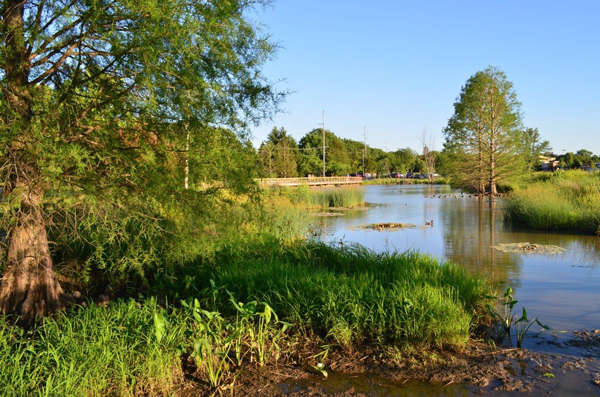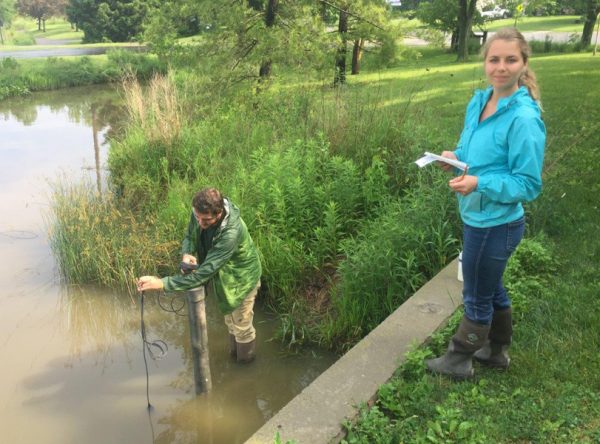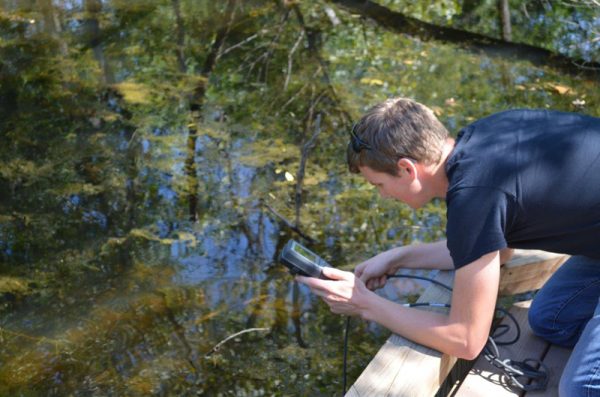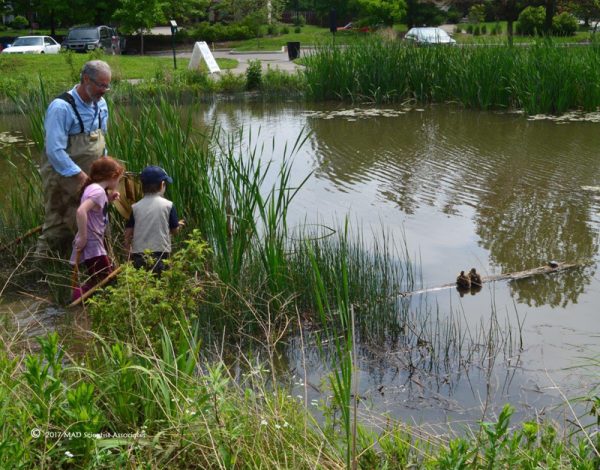Don’t Worry: MAD Scientists have been monitoring and restoring Ohio’s wetlands and streams!

Highlands Park wetland. (Credit: Mark Dilley.)
He doesn’t have crazy hair. He doesn’t walk around in broad daylight wearing a white lab coat. But Mark Dilley and his wife Chris Dilley are MAD Scientists all the way. And they’re both working hard to track the health of Ohio’s waters and even help to restore them.
Their company, MAD Scientist Associates, does not refer to experiments involving lightning, reanimation and a remote German castle. “MAD originated with my initials,” Mark explains. “However, it also stands for Making A Difference, which we always try to do for our clients and the environment.” MAD Scientist Associates is an ecological and wetland consulting firm, dealing with issues such as permits, ecological surveys, plant inventories, and site monitoring. It is a woman-owned business (a true “Mom and Pop Shop” small business) that is in its 20th year of successfully serving a broad range of clients that need environmental services. Chris is the company’s CEO, and Mark serves as Chief Scientist and Project Manager. Together, they have grown their staff to include a variety of specialists that bring many environmental certifications and extensive ecological and wetland experience to their team.
In addition to his role as Chief Scientist, Mark is a Professional Wetland Scientist, Certified Ecological Restoration Practitioner, Chair of the Ohio Biological Survey and President of the Ohio Wetlands Association. He holds a BS degree in natural resources (with a specialization in fisheries management) and an MS degree in environmental science from The Ohio State University. Chris, who is pursuing her MBA, is also an OSU graduate. She began her career at Battelle in Columbus, Ohio. In recent years, she has become a very active member of the North American Woman-owned Business Organization (NAWBO) and has obtained WBENC, WOSB, and EDGE certifications for MAD Scientist Associates. She has taken on her leadership role with vigor and is responsible for planning for the growth and sustainability of the company.
Many facets of their business directly relate to water quality, including biological assessments in streams and the wide variety of wetland services they offer. The MAD Scientist Associates team uses a YSI ProQuatro Multi-Parameter Water Quality Meter as their go-to piece of equipment. They monitor water for basic parameters, including dissolved oxygen, pH and conductivity. “Measuring conductivity and other biological water quality parameters is required when we do electrofishing,” he notes. The team also monitors for turbidity and nitrates and may collect samples for laboratory analysis of dissolved reactive phosphorus, total phosphorus and other analytes.
For performing biological assessments on rivers and streams, the MAD Scientist team follows Ohio EPA protocols. “Most recently, we’ve completed fish sampling on the Olentangy State Scenic River as part of my re-certification as a Level 3 Qualified Data Collector with Ohio EPA. As a Level 3 QDC, the data I submit to the agency is deemed to be suitable for inclusion in Ohio EPA’s dataset,” Mark mentions. “We’ve also sampled fish and invertebrates in Big Darby Creek as part of an Ohio Department of Transportation environmental study for a bridge replacement over this State Scenic River.”
“Although we offer a wide variety of services, a major focus for us is wetlands,” he says. “We do delineation, assessment, permitting, monitoring and design as well as public education. And we are attracting more and more wetland restoration projects, which is work that we find particularly rewarding. On these types of projects, we’re involved in site assessment and design and, if we’re lucky, we also get the opportunity to oversee the construction and get involved in the planting of our wetlands.”

Jenna Odegard and Joe Bevan monitoring Highlands Park wetland. (Credit: Mark Dilley.)
The MAD Scientist team sees huge potential in wetland restoration to improve the health of our watersheds and water bodies, such as Grand Lake St. Marys, Buckeye Lake and the western basin of Lake Erie. Wetlands naturally sequester nutrients, reducing loading to streams, lakes and rivers that are being degraded by eutrophication and harmful algal blooms (HABs). The environmental monitoring they get to do on Ohio’s waters is largely project dependent. “For the past few years, we did monitoring of a wetland we designed,” Mark recalls. “We were especially interested in its ability to remove nutrients. Every week we collected a grab sample near the main inflow and outflow of the wetland. These same locations were also sampled during high-flow storm events. We tracked what happened with nutrient concentrations from inflow to outflow and were able to show our client that the wetland was improving water quality, particularly through the reduction of nitrates.” While their team does not typically monitor for E. coli or fecal coliform bacteria, Mark indicated that studies have shown that wetlands can be an effective tool to reduce E. coli concentrations in some areas.
Mark and his crew routinely complete wetland assessments using Ohio EPA’s Ohio Rapid Assessment Method (ORAM) to determine the appropriate wetland category for regulatory purposes. In certain situations where this rapid (level 2) assessment is insufficient or inconclusive, a more robust level 3 method, such as the Vegetation Index of Biotic Integrity (VIBI), may be necessary. Their company was among the first in the state to be trained in VIBI. This sampling methodology generally consists of establishing a large plot, one-tenth of a hectare (about a quarter acre) in size, across the characteristic plant community of the wetland being evaluated. This plot consists of ten square modules in a long rectangle – two rows of five modules each. Four of the centrally-located modules in the plot are designed as “intensive modules,” where data is collected from three nested quadrats in two corners each intensive module. Data are recorded regarding at what “depth level” (i.e., in which size nested quadrat) each species is first observed and what the percent coverage of each species is within the module. For certain types of wetlands, biomass may be collected from the smallest nested quadrat, which will be dried and weighed back in their office lab.
Although not used as frequently as the VIBI, the MAD Scientists will occasionally also complete an Amphibian Index of Biotic Integrity (AmphIBI) for Wetlands, which is another level 3 method. “Using this method, we would sample with funnel traps three times during the spring and early summer to document the frog, toad and salamander species present in the wetland” he explains. This Ohio EPA methodology was developed primarily for the assessment of forested wetlands containing vernal pools. Vernal pools are small wetlands that are dry much of the year, but come alive each spring, when salamanders and other amphibians use them for breeding.
After an evaluation (be it an ORAM, VIBI or AmphIBI), wetlands are assigned various categories based on their quality. A Category 1 wetland is of lower quality, and wetlands in this category are relatively easy to replicate. These are often younger systems, not as pristine or intact as the higher quality wetlands. These wetlands usually show signs of human impact and have minimal natural buffers to protect habitat and water quality. “A good example of a Category 1 wetland is a roadside ditch full of cattails,” Mark says. “These are common and there’s not a lot of diversity there, though such wetlands still help to improve water quality and protect streams.” At the other end of the spectrum, Category 3 wetlands represent those wetlands that are among the highest quality in Ohio. These tend to be mature forested wetlands with healthy buffers and a general lack of human-induced degradation. “Those have high diversity and are complex systems. A wetland like that is precious. It would be very difficult if not impossible to replace if it were lost,” Mark continues. Fortunately, our state regulations protect wetlands. If one acre of wetland is impacted by a construction project, it must be replaced by up to three acres of new wetland. The difficulty and expense of mitigating impacts to wetlands, particularly those that check out as Category 2 or 3 wetlands, may help to deter developers from disturbing these valuable wetlands in the first place.
When wetland impacts do occur, and mitigation is required, the MAD Scientists use these same methods to evaluate wetland mitigation success. “Ohio EPA sets target performance goals for our mitigation projects, and we pride ourselves on meeting or exceeding these goals on our restored wetlands,” he says.

Aaron Laver uses a YSI meter to collect water quality data on a pond in Dublin park. (Credit: Mark Dilley)
Amphibians are closely associated with wetlands, and Mark and his fellow MAD Scientists have seen some interesting ones over the years. For Mark, one of his most notable encounters was finding marbled salamanders in a South Carolina floodplain when working for a former employer. This black and white patterned salamander occurs in Ohio, but Mark has not encountered one here. “In Ohio, the state amphibian is the spotted salamander, and it’s fun to find those and observe them in the vernal pools – that’s when I know spring has almost arrived.” Although Mark missed out, several staff members recently joined in some exploration of the Audubon Society’s Calamus Swamp. On this trip, the team found tiger salamanders, a species that had never been documented at the preserve. “It’s rewarding when we discover a previously unknown salamander population like this,” Mark adds.
With their work in plant inventories and restoration, Mark and staff sometimes get to find rare plants, too. One interesting find developed out of a project MAD Scientists completed to expand a wetland in Westerville, Ohio. “It was a wetland restoration project where we needed to excavate the site and add water storage capacity to reduce flooding onto an adjacent property,” Mark recalls. “While completing the excavation, we unearthed seeds of the (then) endangered Pale Umbrella Sedge (Cyperus acuminatus), which soon germinated and grew on the newly-shaped wetland edge. It was an exciting and unexpected find.” The story of the Pale Umbrella Sedge has a happy ending: it has since been delisted, as more populations have been found across Ohio.
Doing the hard work of restoring wetlands is easier for Mark these days as the MAD Scientist staff has been gradually increasing. Chris and Mark now employ six full-time staff, one part-time staff, and four seasonal staff. “We have paid internships, which we usually fill with undergraduate Juniors or Seniors from Ohio schools like OSU, U. of Cincinnati, Ohio Wesleyan and Otterbein,” Mark adds. MAD Scientist Associates’ office is located in Westerville, Ohio, close to OSU and Otterbein.
In the 20 years since MAD Scientist Associates was formed, Mark has seen changes over time in area wetlands. “We’ve seen increasing variability in wetland hydrology, driven by changing rain patterns with more intense and frequent storms. Due to climate change and ‘hardening of the watershed’ with increasing development, runoff rates area increased, and the hydrology of wetlands and streams has become more ‘flashy’ and unpredictable. It makes us think about what we can do to make wetlands more resilient in the face of climate change,” he says. “The rate of change with temperatures and rainfall patterns is concerning. We worry that species may not be able to adapt to the changes fast enough.” Other wetland professionals share Mark’s concerns: “I watched a webinar put on by the Society of Wetland Scientists in which one of the presenters pitched the idea of wildlife species conservation through what he referred to as ‘facilitated migration.’ The speaker’s point was that certain vulnerable groups of wildlife, such as amphibians, will be unable to migrate quickly enough to avoid succumbing to extinction in the face of climate-change-induced alterations to their habitats. Therefore, he advocated for capturing and transporting salamanders and frogs in trucks to relocate them northward into zones that will present conditions that are tolerable and necessary to their survival. We hope it’s not going to get that bad, but this is one of the ambitious ideas being discussed as a possibility to maintain species diversity,” Mark muses. “Restoring forests and natural wildlife corridors will also be key to helping out these species so they can move where they need to go to survive. We’re really at a point where we need to get serious about solutions, and we think nature-based solutions are best.”
While considering solutions for wetlands and wetland creatures faced with climate change, Mark emphasizes it’s not just the salamanders and frogs that would benefit from a solution. “Investing in wetlands is really in everyone’s best interest, not just the wildlife. Wetland investment benefits people, too. Whether we are aware of it or not, wetlands make our planet more livable and can improve our health, safety and general quality of life,” he says.
The impact of wetlands was something Mark discovered during the course of his education. “I pursued a fisheries management major for the simple reason that when I was in high school, I enjoyed fishing,” he admits. “While in college, I became involved in the Stream Quality Monitoring Program through the Ohio Department of Natural Resources. Through this activity, I became increasingly interested in water quality and soon learned that wetlands were essential for river and stream health. However, over 90% of Ohio wetlands are gone. They have been lost to agriculture and development. That means nature’s filtration system is almost completely gone as well.” Wetlands have been referred to as “nature’s kidneys,” as they excel at removing contaminants from waterways.
Wetlands have a profound impact on water quality, and they support an unusually high level of diversity of wildlife compared to other environments. “Wetlands are the ecotone between aquatic and terrestrial environments, and they support species from both environments and therefore can be incredibly species-rich,” Mark explains.

Mark Dilley explores the Highlands Park wetland with children attending the Westerville Wetland Workshop. (Credit: Jenny Adkins)
“One of our most popular projects, one that has had a very high community impact, was our Westerville Wetlands restoration project,” Mark says. “The City of Westerville received a water quality grant from the Ohio EPA to restore the Highlands Park wetland in Westerville. It was a low, previously farmed area that, due to the failure of the subsurface drainage tiles, was becoming increasing flooded and choked with invasive cattails. When the park and community pool were to be renovated, we recommended moving the soccer fields and new pool back from the wetland to expand and enhance this degraded wetland and make it a central feature within the park. The project was completed in 2013, and the return of the wildlife since then has surprised us.”
Highlands Park wetland, which used to have little if any amphibian use, now supports seven species of frogs and toads. “There is now so much amphibian activity that we have started a program for the City we call ‘Frog Fridays,’ where local kids come out to the park to learn about the value of wetlands and look for frogs and tadpoles, which they can catch with nets and release after we get a look at them. They had never been able to do that before in the area.”
In order to work the miracle of wetlands restoration at Highlands Park, Mark and his team designed the wetland to take advantage of the pulsing hydrology resulting from the influence of storm drains that flow into the wetland. They also attempted to optimize the water quality treatment function by increasing water storage and extending the residence time of water moving through the wetland. “The stormwater flows, historically, passed straight across the site and into another pipe at the opposite end, and the residence time just wasn’t long enough. So we excavated the area to form a wide ‘meandering river,’ which gave the water a longer residence time and created more opportunity for particles to drop out of the water, lowering turbidity. We also took out the invasive cattails, which tend to create an undesirable monoculture that limits diversity. The results speak for themselves: The human community is very happy with the changes, and so is the wildlife.”
In addition to monitoring Ohio waters and restoring wetlands, MAD Scientist Associates also provides education services and public outreach. They offer hands-on STEM learning programs with an environmental focus for students, as well as teacher training and curriculum development. Through his role with the Ohio Wetlands Association (OWA), Mark is also helping to develop training materials for the Ohio Vernal Pool Network, a collaboration of OWA and the Midwest Biodiversity Institute. “We have a goal of developing training materials to help citizen scientists better monitor, protect and advocate for vernal pools in Ohio,” says Mark. “Formal and non-formal educators will be encouraged to join as affiliates and get these materials. We’re hoping to attract a wide variety of educators to enhance this important statewide training project.”
The dedicated staff at MAD Scientist Associates truly enjoy their work, and they hope to draw more people to wetlands and wetland education events. Residents near the Highlands Park wetland restored by Mark and his team, for example, have been thoroughly enjoying the return of their wetland. “A local photographer in Westerville told us wading birds were his favorite subject, and that now that the Highlands Park wetland has been restored, he’s seeing these unique and beautiful birds on a regular basis! He has seen great blue herons, green herons and great egrets – often all in the wetland at the same time – and has been just completely delighted that these birds are now showing up near his neighborhood. That’s been very gratifying for our team,” Mark says. “It’s great to see the public fall in love with wetlands just like we have.”




0 comments